Campaign Details: Shocking Amur Falcon Massacre in Nagaland!
This is a documentation of the shocking massacre of tens of thousands of migratory Amur falcons (Falco amurensis) in the remote state of Nagaland in India’s northeast. We estimate that during the peak migration 12,000 – 14,000 birds are being hunted for consumption and commercial sale everyday. We further estimate that a mind-boggling 120,000 to 140,000 birds are being slaughtered in Nagaland every year during their passage through the state.
This is probably the single largest congregation of Amur falcons recorded anywhere in the world and it is tragic that they meet such a fate. Our team has alerted all appropriate authorities in Nagaland. Government officials we spoke to have committed to put an end to the slaughter and have initiated specific action steps outlined below. Conservation India will continue to monitor and report on the situation.
It is significant to note that India, as a signatory to the Convention on Migratory Species (CMS), is duty bound to prevent this massacre, provide safe passage, as well as draw up appropriate action plans for the long-term conservation of this bird. In the recently concluded Convention on Biological Diversity (CBD), of which India is the president for the next two years, the importance of CMS in conserving species, and especially in stopping bushmeat hunting, was repeatedly stressed.
Background
In October, huge numbers of Amur falcons arrive in northeast India from Siberia en route to their final destination — Somalia, Kenya and South Africa. This handsome little raptor has one of the longest migration routes of all birds, doing up to 22,000 km in a year. The birds are unusual in that they migrate a large distance over the sea and also continue their journey at night. In October this year, a group of us (Ramki Sreenivasan from Conservation India, Shashank Dalvi, Bano Haralu, Rokohebi Kuotsu) travelled to Doyang reservoir in Wokha district to check out information that thousands of falcons were being hunted annually on the banks of the Doyang reservoir during their passage through Wokha district, Nagaland. The trip confirmed our worst fears. Doyang is a rockfill dam and hydroelectric plant on the Doyang River, a tributary of Brahmaputra, 30 km from Wokha town in Nagaland run by the North Eastern Electric Power Corporation (NEEPCO). On Oct 21, as we were reaching Doyang reservoir at 0830hrs, we found two women walking along the road openly with about 60 skinned birds that turned out to be amurs. This was our first encounter with the species. We saw the dead birds even before we saw the live ones.
Number of Amurs around Doyang
Almost immediately, we saw thousands of amurs on the transmission lines along the mountain ridge. They seemed to travel overnight and reach Doyang during the early hours. They seemed to use these wires for resting and hawking insects. Amurs are known to be wholly insectivorous (Irwin 1981). Here we estimated ~6000 Amur Falcons at 0840hrs. This count was only from the wires visible to us, and the wires stretched for hundreds of meters in each direction (see attached slideshow). The next morning (Oct 22), at 0630hrs we counted ~12,000 birds on the same wires and ~23,000 birds flying above the Doyang reservoir. Later at 0830hrs the birds were seen using transmission lines. The numbers dropped considerably and by 1230hrs, very few falcons were seen on the wires. Over the course of the day, we observed 12 hunters on the main road carrying between 60-200 birds per head totaling over a 1000 dead birds carried to their homes or local markets and even door-to-door selling.
The Massacre
1. Hunting process
The amurs spend the day on the transmission wires (almost entirely inaccessible to hunters) and descend to forested patches along the banks of the reservoir to roost (see map). The hunters ruthlessly exploit this particular behavior and set-up huge fishing nets (30-40m long, 10-12m tall) all over the roosting sites.
We accompanied one hunting group (of 4 hunters) to the other side of reservoir by rowboat where we saw several other hunting groups. Hunting groups consisted mainly of four hunters; some parties had two.
Birds get caught in the nets in large numbers. These birds get tangled in the nets while they come to roost during late evenings or when they leave the roost early in the morning. The nets were permanent and the hunters come every morning to remove the trapped birds. The nets were observed over the entire roosting area giving virtually no safe area for the birds. Branches and paths were cleared to set up the nets.
Each hunting group had set-up at least 10 nets. On an average, 18 birds (18.30, n=23) were caught per net; hence each group catches about 180 birds per day. This was confirmed with interviews with hunters. We were also informed that about 60-70 hunting groups operate every day. This means during the peak migration about 12,000 to 14,000 birds are caught everyday. This obviously results in a loss of very significant number of birds from population everyday. This year hunters started netting on 19th Oct (interview with hunter) and the netting will apparently continue till the end of migration. According to hunters the peak migration lasts 2-weeks (our group will confirm this over the course of the next week or two, plus will study it next year). Assuming just 10-days of peak migration through Doyang, this suggests a shocking 120,000- 140,000 birds removed from the population every year, and more if the migration lasts longer or if there are more hunting sites in the area (neighboring villages, districts, etc.). This number doesn’t include birds potentially killed using guns, catapults, etc. — a widespread and accepted practice amongst Nagas.
The captured birds are kept alive in mosquito nets or cane baskets near the nets so they can be exported alive to the customers and markets. From cane baskets, the birds are transferred to poles for ease of carrying into villages and towns. Birds eventually die in the process and these birds are de-feathered / plucked (like poultry) and smoked for sale (longer shelf life).
2. Sale
Each bird is sold for a price between Rs. 16-25 (always sold as number of birds for Rs. 100 ($ 1.9 / £ 1.2). This sale usually happens door-to-door in Pangti village (where most hunters are from) as well as nearby Doyang and Wokha towns. Hunters (and sellers) know that Amur killing is illegal and banned by the Deputy Commissioner (Wokha district) since 2010 vide an issued order (Order no: JUDL-13/DR/2008-09/ Dated, Wokha, the 16th Nov. 2010). We also came to know about a few Amurs on the sale in open markets in Dimapur, in the plains far away.
It is still a mystery where huge numbers of dead amurs go everyday, as the local villages cannot absorb such numbers for their consumption. One of the hunters told us that two pick-up trucks from Dimapur were to pick-up the birds from Pankgi village (we couldn’t confirm this and passed on the information to the District Commissioner and Superintendent of Police). It is critical to understand where the bulk of the birds go.
By the end of the day, with the stench of smoked amurs in our heads, the scale and the ruthlessness of the massacre numbed us.
Recommendations for Immediate Action
- The roosting place is localised (one specific bank of the reservoir) and can easily be sealed off by the authorities (Deputy Commissioner, Superintendent of Police, North Eastern Electric Power Corporation (NEEPCO) and Forest Department).
- Gain an understanding of and seal trade of amur meat mainly in big towns like Dimapur, Kohima.
- Aggressively follow-up on the enforcement of the DC’s ban with Forest Department, Police, local communities and the Church.
- Create awareness of the ban and the legal consequences (fine) in all villages including Pangti, Wokha, Doyang and Sungro.
Progress after our complaints
State-level
- On the very same day as our verbal complaint (Oct 22nd), the dynamic Deputy Commissioner (DC) of Wokha district issued a fresh order against hunting of amur falcons (see new and earlier orders). This order was also carried in local newspapers. He also intimated the superintendent of police of Wokha about the killing and the potential trade in amur meat. He also alerted all community leaders in the area to enforce the ban. He set-up a meeting for our team member Bano Haralu to address the village leaders on 29th October 2012.
- The Divisional Forest Officer (DFO) of Wokha district Mr. Supongtakshi Aier and a district administrator addressed approximately 50 village heads, council members and student bodies of Pangti, Sungro and Akhotso villages in Pangti (since most hunters are from Pangti, the village closest to the Doyang reservoir).
- The government officials categorically stated that any ongoing trapping and killing of birds after the DC order was a violation of the law and it would not be accepted. The respective village representatives were asked to inform their communities about the order and that violators would be fined. Village heads have agreed to inform their communities about the status of the Amur Falcons and to spread the message of being “guardians” to the birds rather than being “destroyers”. However, they expressed helplessness to put a total stop to the killing if some measures are not put in place to replace the “economy”generated by the killing of the birds during this season. The govt. has to address this on priority before the next season.
-
The Chief Wildlife Warden of Nagaland Mr. T. Lotha has issued instructions to his staff to seize all traps found in the area and has warned of stern action including arrests against offenders. Forest guards and personnel have been on duty since, and will remain till the end of the migration to monitor the situation. They have also begun to confiscate all live and dead birds caught by villagers. Live birds have been released and dead birds burnt. In some spots, nets put up by hunters have been removed.
- A more robust and proactive plan is being thought out to be effectively implemented next year in the month of September a month before the migration season.
National-level
- The issue has been brought to the notice of the Minister of Environment and Forests, Smt. Jayanthi Natarajan, following the meeting of the standing committee of the National Board for Wildlife (NBWL) on Oct 31st, 2012 in New Delhi. The director of BNHS and member of NBWL, Dr A R Rahmani has written to the Hon’ble Minister to request the Chief Minister of Nagaland as well as the forest department of the state to immediately stop the massacre, and draw-up a long term conservation action plan for the species.
- India has repeatedly pointed out that migratory birds are killed on their way to India in other countries — the primary reason why the Siberian Crane is now locally extinct in India. This incident goes to show that bloody, seasonal hunting sprees targeting migratory species is happening in India too, and we have to take immediate action to stop this.
We will continue to update this page and send out emails to CI readers.
Additional information
The marathon migrant
The Amur Falcon is a complete, long distance, trans-equatorial migrant (Bildstein 2006). It has one of the of longest migration routes of all birds — doing upto 22,000 km in a year — from eastern Asia all the way to Southern Africa and back. It also is unusual in migrating over sea and migrates during the night (Meyburg 2010). Migrating birds leave their Asian breeding range and travel to northeast India and Bangladesh, where they fatten up while staging for overland flights over peninsular India (Ali and Ripley 1984). Subsequently, they undertake the longest regular overwater passage of any raptor, crossing over the Indian Ocean between Western India and tropical East Africa, a journey of more than 4,000 km, which also includes nocturnal flight (Bildstein and Zalles 2005). This species is finely attuned to the strong monsoon tailwinds, which results in its late arrival in eastern Africa in autumn (Ash and Atkins 2009). Migrants arrive in their southern African winter range in November-December and depart by early May (Mendelsohn 1997). This species is an “elliptical migrant” (Kerlinger 1989), and its return route back to its breeding range is largely overland and to the north and west of its southbound route (Bildstein and Zalles op cit.). Useful articles:
- The amazing saga of this Amur Falcon.
- Amur Falcon migration route finally plotted.
- Amur falcon fact file.

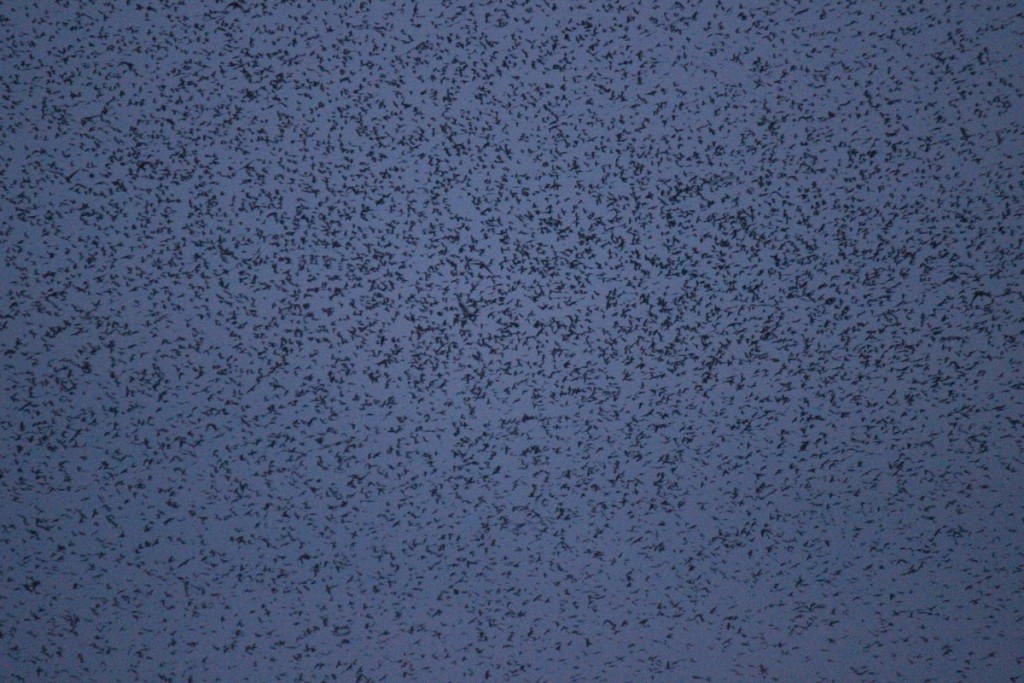
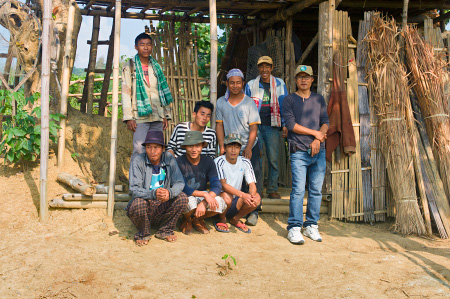



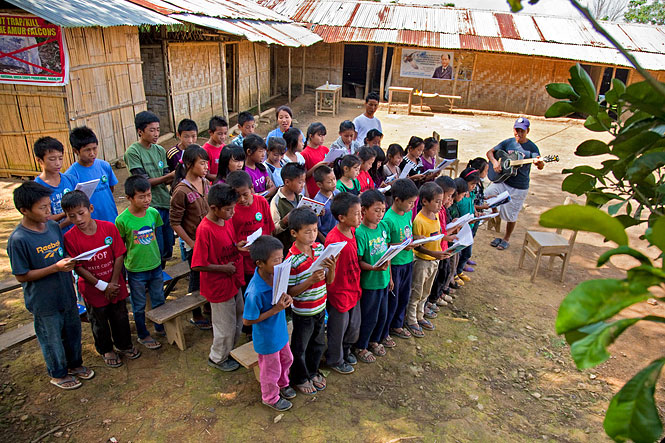
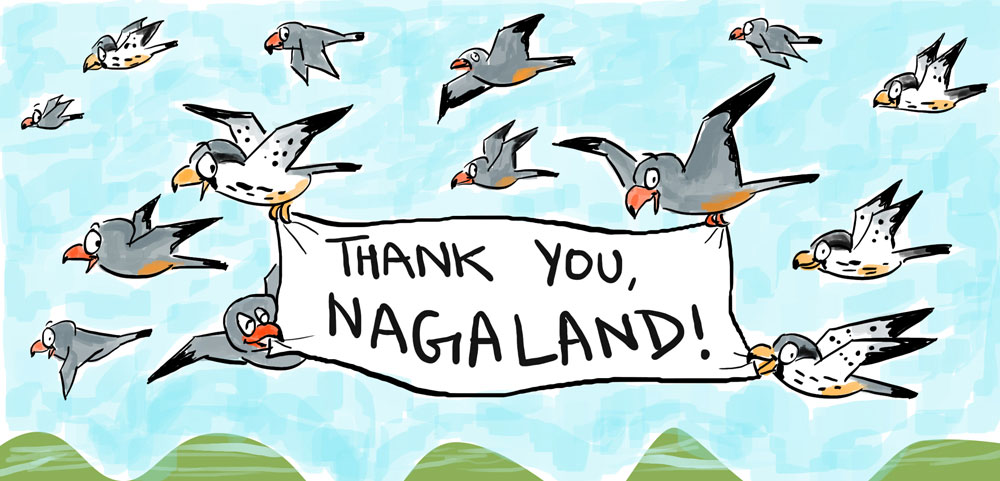

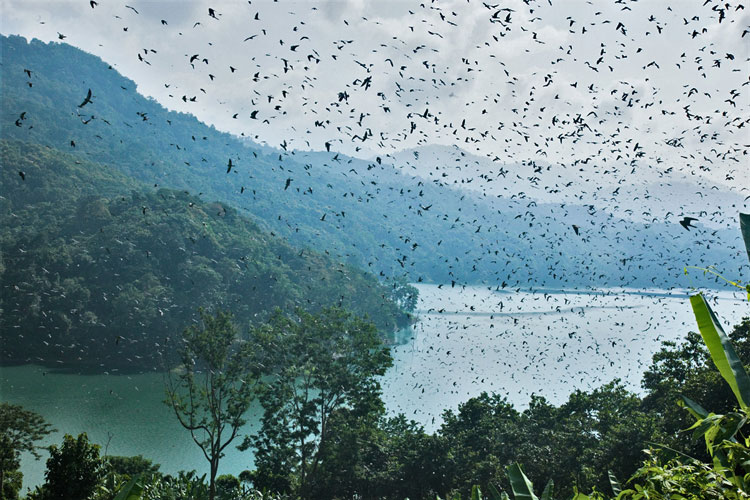
 CI is a non-profit, non-commercial portal that aims to facilitate wildlife and nature conservation by providing reliable information and the tools needed to campaign effectively.
CI is a non-profit, non-commercial portal that aims to facilitate wildlife and nature conservation by providing reliable information and the tools needed to campaign effectively.
Older Comments 27
It is extremely disappointing to see these magnificent birds coming from so far off places meeting such tragic end in the hands of a few greedy men. I think these people themselves also do not realize that, the gravity of the crime they are committing. May be because of their ignorance and more because of the callous attitude of the authorities. And We say “Athithi Devo Bhava” .
Now this must stop and that to happen there needs to alternative mode of income generation for these class of people which would be more remunerative than hunting these falcons. I highly appreciate the efforts of the authors and team to bring this to light. Probably now this short video can be shown in some leading news channel to make the authorities both at the state and the center to take notice and more importantly act.
I am shocked. I had only herd of something like this happens in the tribal areas but to such a extent is just too much. Educating the locals is very impt, the local govt have to step in immediately as they can communicate & are aware of such happenings in their area but I guess for some reason they just don’t wana stop such crimes. I only hope support to this cause grows and action is being taken in the right way. I am dead sure we are just on a tip of a an iceberg…
I am thankful to CI team for this email and bringing up this matter to the national level. I would like to suggest everyone to please write to Wildlife Crime Control Bureau and bring it to their notice that this must be immedietly stopped. Unfortunately, I am unable to locate the WCCB nodal officer contact details in my contact list. But, if someone having that, please share it so that we can also build pressure on them for quick action. In my opinion it is must to urgently gain the confidence of local communities and the local FD and administration is the best to do this.
I emailed Rina Mitra (the Addl directorate of WCCB) and brought this to her notice.
This is not only shocking but sad and for country like india where guest is treated as god, now you know why there is no space for animals and birds in india. people in this country behave like animals. What is our minister doing is it not proof to catch offenders. low income or high is no way an escuse to break law. Only one remeade enforce law with iron hands.
This is extremely sad news!! 🙁 The last i had heard of something like this was the capturing of Blue-tailed Bee-eaters from Karnataka. Now that your team(Im glad people like you all roam this earth) has these records, the government will take serious steps in ensuring this does not happen again.
Here is a related posting on bngbirds@yahoogroups:
To: bngbirds@yahoogroups.com
From: S. Subramanya subbus@vsnl.com
Date: Sat Feb 6, 2010 8:29 pm
Subject: Plight of the Amur’s flights… [long]
The Amur Falcon (Falco amurensis)
http://www.biodiversityexplorer.org/birds/falconidae/images/220_male_Amur_Falcon_327w.jpg
http://www.indianaturewatch.net/displayimage.php?id=67991
http://www.indianaturewatch.net/displayimage.php?id=69451
http://orientalbirdimages.org/search.php?p=1&action=searchresult&Bird_ID=1064
http://orientalbirdimages.org/search.php?p=7&action=searchresult&Bird_ID=1064
http://orientalbirdimages.org/search.php?p=10&action=searchresult&Bird_ID=1064
http://orientalbirdimages.org/search.php?p=30&action=searchresult&Bird_ID=1064
http://orientalbirdimages.org/search.php?p=31&action=searchresult&Bird_ID=1064
The Amur Falcon is a smallish dark sooty brown raptor with chestnut on the vent which sets it apart from the European Red-footed Falcon (Falco vespertinus), to which it is closely related and can easily be confused with. These Amur Falcons breed from eastern Siberia eastward through Amurland to Ussuriland and south through northern Mongolia and Manchuria to North Korea, northeastern China, and southern Japan. Using north-eastern India as their main flyway, these falcons winter in northern Botswana and Malawi , and south through South Africa.
(http://www.biodiversityexplorer.org/birds/images/sabap/sabap2_map_smoothed119_mid.png). The bulk of these birds are known to have several staging areas in Assam, Meghalaya and Manipur, where they congregate in huge numbers before they fly across the Arabian Sea and Indian Ocean towards
South Africa.
I have been interested in the Amur Falcon ever since 2008, when I was invited for an Amur Falcon conservation initiative in Nagaland, where 1000s of these magnificent falcons were being slaughtered for the pot each winter, but never made it. My March 2008 visit to Nameri Wildlife Sanctuary through which small flocks of these falcons are known to fly past, was five months too late to, even set my eyes on them. My recent meeting with Dr. Anwaruddin Choudhury, a leading authority on the birds of the northeast and a close friend, helped to put pieces in place on the plight of the large flights of Amur Falcons.
The Habang area found within the remote district of Karbi Anglong, of Assam, and located close to the border of Nagaland’s Khasi and Jantia Hills, comprise a few small hamlets inhabited by Khasis, Nepalese and a few Karbis. Every winter, Amur Falcons are known to congregate in huge numbers and as many as 3000 birds have been sighted on a single night when they come to roost in the Habang area. It is not just Habang, two more areas, one each in Nagaland (Mokokchung district) and Manipur (Tamenglong district) play host to huge flocks of these birds as well.
Every October and November, the villagers, both Khasis and Nepalese in Habang, eagerly wait for the arrival of Amurs to roost in their areas. Typically, these Amurs prefer to roost on vast bamboo thickets and perch on the emergent bamboo stems. The habangs build rough platforms – makeshift machans, close to the canopy of the bamboo clumps, by pulling together several bamboo stems and tying them with a rope. The whole village is known to engage themselves in this age-old ritual. Sitting on these machans, the habangs catch the Amurs with bare hands as they come to settle on the bamboos during dusk and sometimes through the night to grab the roosting birds and stuff them into gunnysacks. Each one would then descend down from the machans with bag full of Amurs. While most of the night’s capture is eaten, many of them are sold in urban areas such as Shillong.
For over a month starting from mid October, an estimated 90,000 birds are known to pass through Habang area and many of them get slaughtered, never to fly any further on their long journey to South Africa. During the season, these falcons can be seen perched on powerlines like the swallows do, or in flight all over Umpanai, between Umpanai and Amsoi and also in other adjacent areas. From Habang, the Amurs are known to fly through Meghalaya – near to the border of Khasi and Janthia Hills – and towards the Sylhet plains of Bangaladesh. Many of the Amurs are also known to take a different route – through the Mokokchung and Wokha districts of Nagaland and Tamenglong district of Manipur and then to Bangaladesh through the Cachar plains of southern Assam.
The hunting Habangs, hardly know that the Amurs are migrants from a far-off region and remain in their area as guests on a daily basis, before those that escape slaughter, continue on their long journey towards South Africa. To the Habangs, arrival of the Amurs has always been a god’s seasonal
offering of meat in plenty. So much so that, some of the remains of the overkill are quite often thrown away to rot on garbage piles.
This very thought is enough to mute you into silence and freeze your blood, and just to think that those images of the Amurs posted above were taken in relatively more happier times for the birds. This plight of the Amur flights in nothing less dramatic than the river crossing of the migrating Wildebeest across Masai Mara, where the Nile Crocodiles lie in wait for an opportunity of plenty.
Source of info: Anwaruddin Choudhury.
For a detailed treatment of this subject, please see:
Choudhury, A. 2009. A Naturalist in Karbi Anglong. Gibbon Books, Guwahati, Assam, India.
Cheers,
Subbu
Nagaland , Shame on you.
Jai.
So sad, was shocked to see the staggering numbers of Amur falcons being killed everyday 🙁 . Nagaland Government has to take immediate action against this massacre and provide a safe passage for these magnificent raptors.
Hard to decide who is Hunter that amur falcons or we the PEOPLE…:(…:'(
I think only punishment to those people can stop all this thing.
immediate action should be taken on them.
and
someone should contact conservator who is on duty there.
Thanks for the detailed coverage and follow up actions reported. CM Inglis in his 1911 Book, Birds of Southern India, records similar mass capture and sale of these birds in Andhra Pradesh. He called them Eastern Red-legged falcons, and mentions that because of their red-legs they were sold as ‘pigeons’.. Do these birds still migrate through Andhra or have they been extirpated there in the century since Englis reported similar slaughter?
Your report is also an effective expose’ of not just this particular case if market friendly wildlife slaughter, but also of the great risk involved in relying on the much-hyped’traditional tolerance and reverence for nature’ as the sole conservation strategy..
I was in Nagaland for several years during the 1990s and I remember the markets in Mon district being flooded with live Amur falcons during the ‘season’. Though I inquired about the source of these birds or where they had been trapped, I never got a convincing reply. The sellers would keep them in woven bamboo cages, in twos or threes and even senior Govt. officials would buy them. Those days I was not aware of Amur falcons or its migratory stories, but it was disgusting to see people playing with the caged & helpless birds, as they aggressively defended themselves when being poked with sticks or fingers by perverted scoundrels. Besides the sheer number of birds being sold in the markets of Mon itself was intimidating, even to someone used to seeing all sorts of wildlife being dismembered, displayed or sold openly on the streets.
Author
Raj Phukan — Thanks! Please ping me with more information of Amur hunting / trade in Mon. The DFO Mon says that there isn’t hunting anymore in Mon but that was said of Wokha also (where this massacre has been reported from)! By next year, we need to ensure that all hunting locations are identified and patrolled.
This is an appalling story and an embarrassment for India. The designer-rip-off uniform worn by the faceless bird-trapper also gives the lie to the notion that tribals must always be seen as a people apart.
Deeply saddening. I was shocked to see the video itself, what could’ve gone through you all while seeing happening in front of you would’ve been so painful. I hope with your expose the government will put a stop to this. This is a mass massacre and like you have mentioned the killing is more than the capacity of those towns…it is commercial and not a sustainable tribal hunting!
Is it possible to start a campaign to gather signatures online for this? The “bulk” of the public can be powerful…
I CAN’T BELIEVE WHAT I SAW HOW UPSETTING THIS IS I HAD TO STOP WATCHING THIS VIDEO.
IT MADE ME ANGRY AND SO UPSET HOW CAN THIS COUNTRY HOLD ITS HEAD UP HIGH.
I WANTED TO GRAB THOSE PEOPLE AND HURT THEM SOOOOO MUCH BACAUSE OF THE WAY THEY WERE CATCHING AND SELLING THOSE FALCONS FOR FOOD.
I HAVE BEEN AT A BIRD OF PREY ACADEMY FOR JUST OVER A MONTH AND LOVE EVEY MINUTE OF IT.
I HOPE THESE PEOPLE GET PUNISHED FOR WHAT THEY HAVE DONE ITS WRONG ITS INHUMAIN AND NO ANIMAL SHOULD BE PUT THROUGH THIS.
I HOPE THE GOVERMENT ARE GOING TO DO SOMETHING ABOUT THIS ASAP BEFORE MORE FALCONS ARE KILLED.
ALL THEY ARE DOING IS MIGRATING AND STOPPING OFF FOR A REST THERE NOT HURTING ANYONE SO LEAVE THESES BEAUTIFUL FALCONS ALONE.
It is shocking to know migrating birds are killed systematically in India. I request the concerned authorities in the government of India and the government of Nagaland to take stringent measures to stop the killings of these birds, and also request to punish the culprits. For us in Karnataka migration of birds is an occasion to celebrate, as if the daughter of the house is visiting. I hope good sense prevails in Nagaland.
I live close by where this is happening. My native place is just 2 hrs drive fron there. Saw a couple of flocks in their hundreds..possibly thousands 2 weeks back. Nagas are deep rooted in hunting practices. But lately, many of our people have begun indiscriminate destruction of wildlife with modern techniques, arms etc. As made to belief that tribals practices sustainable hunting, this is not,nor this is a matter of survival for hunters/trappers. For many Nagas, hunting is a favourite pastime. Therefore, writing to authorities would’nt be of much help. In fact, even some highly placed govt. officials are enthusiastic hunters themselves. This practice has been there a longtime and authorities are reluctant to act tough against practices despite stringent laws being enforced by the govt. OK! govt. is not sincere & helpless in tackling this issue? what can we do? My humble suggestions:
1. highlight your concern as much as possible in print media (not electronics) as this would be the only way to reach these people(Nagaland Post & Morung Express are 2 widely circulated newspapers here).
2. where govt. failed Village coucils have suceeded. where village coucils dictates govt. relents. Involving village coucil is a must. In fact, couple of sorrounding villages and ranges have successfully implemented hunting prohibiton.
whatever, let us protect this majestic global companion.
Sorry but my english is not as goos as I like. Good work to report it. It’s a shame. The solution is, to take punitive measures that are proposed, but in turn, generate more benefits to the people, for alternative ways to the sale of these animals in the markets. It seems that not sure what the fate of most of them, and you say that the local population is unable to absorb such a large number of individuals. (Would not surprise me that traditional Chinese medicine, grant something magical to this hawks). Surely many people would pay to witness the migration of Amur Falcons in this venue. Would have to generate some kind of income that would generate ecotourism infrastructure in local populations. I hope this horrible hunting finish. Thank you.
I think so it will be good, to do a campaign to gather signatures online for this.
I have created a campaign to gather signatures for this.
Please chack this:
https://www.change.org/en-IN/petitions/jayanthi-natarajan-minister-for-environment-and-forests-govt-of-india-stop-the-shocking-amur-falcon-massacre-in-nagaland-india-3
I wrote a letter to India-Tourism-Office here in Germany:
“Dear sirs,
we are tour-operator in Germany working in sustainable tourism. We are rather well-known in Germany, because we have won 9 times the “Goldene Palme” Award from GEO Saison, the biggest German traveller magazine.
We are operating several trips to your beautiful country. One of this trip is a birdwatchingtour to India, which is very succesful.
Now, we got informations from several birdwatchers, that in Nagaland they don´t really care about rare birds. 120.000 – 140.000 of the rare Amur-Falcon are slaughtered every year.
We want to ask you to do something against this bird-slaughter. It makes a very bad picture of Nagaland and India if you kill such beautiful and endangered birds. Here in Germany we have 400.000 of birdwatchers who will be informed about this massacre, soon. In UK there are much more than 1 Mio birdwatchers. Beleive me, this is a very negative picture of India. We have the first cancellations for our birdingtrip, because nobody wants to watch birds in a country with massacres like that.
Here you can find more informations:
http://novataxa.blogspot.de/2012/11/amur-falcon-massacre-nagaland.html
http://www.conservationindia.org/campaigns/amur-massacre
—
With kind regards
************************************************
Rainer Stoll (CEO)travel-to-nature GmbH
Franz-Hess-Str. 4
D – 79282 Ballrechten
Tel.: +49 (0)7634/5055-10
Fax.: +49 (0)7634/5055-29
Skype: travel-to-nature
http://www.travel-to-nature.de
http://www.facebook.com/traveltonature
Mitglied im Haus der Spezialisten: http://www.erlebnisreisen.org
___________________________________________________
Handelsregister Freiburg, HRB 310868
managing director: Rainer Stoll”
I just started a on line petition for Amur Falcons on change.org
Here is the link to the petition
https://www.change.org/en-IN/petitions/jayanthi-natarajan-minister-for-environment-and-forests-govt-of-india-stop-the-shocking-amur-falcon-massacre-in-nagaland-india-3
Please pass on the link and get people to sign the petition.
I also needed the email address of the Ministry of environment and forests. to update it in my petition. It would be great if someone could provide this.
un scandale comment un pays peut il laisser faire de si horribles choses que dirons les enfants ces prochaines années lorsque l’espèce sera exterminée . PAUVRE PLANETE
Thank you for finding the facts and sharing with the world….Now let’s see how the Government plays its role..Don’t know whether the falcon population can take this massive blow with 120,000 -140,000 individuals slaughtered in such short time.Don’t really know how many more of them are surviving now.If this slaughter continues in the coming years also, the amur falcon may eventually come to the brink of extinction. Could not see the video, my eyes started watering. This may well be the worst crime ever committed on the avifaunua. Have never heard of crime in such a magnitude. Also India’s reputation has taken a serious beating. Thanks to these locals. It’s such a shame..
In Nagaland it very difficult to implemant the conservation laws. The local people have their own traditions and they do not care for central laws. Officials find it difficult even to enter the area.
It necessary to study the situation at field level and explore how to proceed under prevailing law and order conditions. As far as I know the officers are well aware of the situation but prefer to keep quiet.
My intention is not to discourage any effort in this direction but be careful and proceed cautiously.